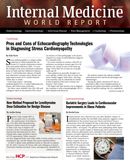Publication
Article
Internal Medicine World Report
Gown Up or Isolate the Patient? Where's the Evidence?
Author(s):
Methicillin-resistant Staphylococcus aureus (MRSA) and vancomycin-resistant Enterococcus (VRE) have become significant and costly problems-so significant, in fact, that many patients have a basic knowledge of MRSA just from news reports. The Centers for Disease Control and Prevention (CDC) offer a large selection of free tools to educate the public about MRSA and VRE.

Methicillin-resistant Staphylococcus aureus (MRSA) and vancomycin-resistant Enterococcus (VRE) have become significant and costly problems—so significant, in fact, that many patients have a basic knowledge of MRSA just from news reports. The Centers for Disease Control and Prevention (CDC) offer a large selection of free tools to educate the public about MRSA and VRE. In hospitals, finding the most efficient, effective and budget-friendly precautions is a constant discussion topic. Are (standard precautions like gown, glow and hand hygiene and infection prevention bundles) sufficient intervention? What else should we do and what’s overkill? A new review published in the October 8, 2014 issue of JAMA discusses precautions with an emphasis on contact precautions in patients colonized or infected with MRSA or VRE.
Contact precautions are a step up from standard precautions. They encompass single-patient rooms, dedicated equipment, and gowns and gloves whenever healthcare personnel deliver patient care. Clearly, this can be costly and inconvenient; healthcare providers’ adherence rates are estimated to be less than 80%. In addition, visitors often stop coming once contact precautions are in place, isolating the patient and decreasing satisfaction. This paper’s authors indicate that when emerging-resistant organisms (MDROs) are identified and our understanding of the specific organism is limited, use of contact precautions is sensible. For MRSA or VRE, however, they recommend contact precautions as a secondary measure only when standard approaches fail. In particular, reducing transmission is critical during outbreaks or when infection rates climb despite best efforts at prevention.
Most US hospitals report endemic, non-outbreak MRSA or VRE infections. Hospital use contact precautions often, but evidence efficacy is scant. The CDC reports “it has not been possible to determine the effectiveness of individual interventions, or a specific combination of interventions, that would be appropriate for all healthcare facilities to implement in order to control their target MDROs.”
This review covers the steps involved in MDRO acquisition and infection and data that suggests that MRSA acquisition is uncommon in non-colonized adults. Approximately 20% of apparent acquisitions occur as patient-to-patient transmission—the remaining 80% have other mechanisms. It is possible that increasing hand hygiene compliance and decreasing health care worker visits could address transmission effectively.
Several large healthcare systems have stopped using contact precautions. The authors call for high-quality quasi-experimental study or cluster-randomized trial comparing the effect of adding contact precautions to standard precautions in MRSA and VRE.






